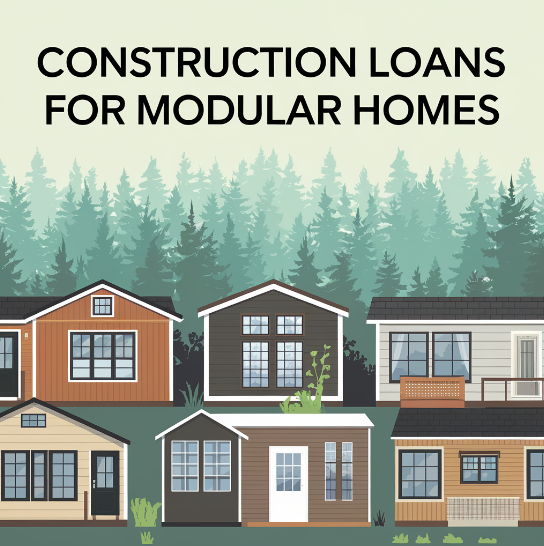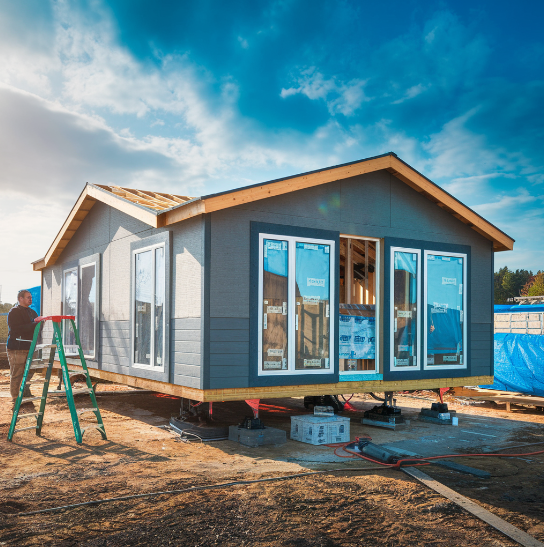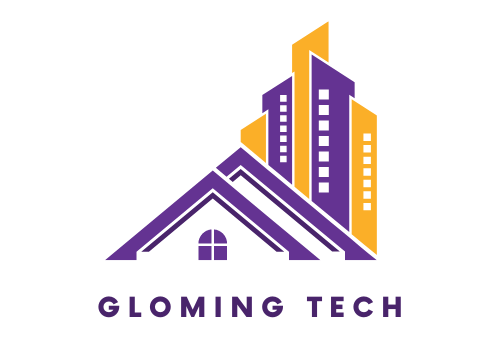Introduction: Construction Loan For Modular Home

When you want to start your self-build home, but would like it to be as convenient, cost effective and offers you flexibility by going for modular construction, obtaining a modular construction loan can be the right step. These self-build loans also promise to meet the challenges that come with the unique construction loan amortization schedule of a modular home construction as opposed to standard bank loans. With the right mortgage in place, you can foresee the course of doing things in modular home construction, budgeting and timing. In this piece you well understand how construction loans for modular homes work, their advantages and how to get the best loan for the modular home you are after.
Understanding Modular Homes

Modular homes are factory-made sections that are manufactured in factories before being transported to the location of assembly. They do not rely on entirely building the houses on the premises, modular homes are partially constructed in a different location saving a lot of expenses and cutting short the construction timelines. These homes still meet the appropriate durability and safety codes enforced for the conventional on-site built homes and its design as well as customizing options include many aspects.
While increasing in demand, modular homes have been able to attract customers through their bargain cycle. With changes in technology, these houses are competitive with the standard ones regarding interior decorations and usage. In addition, the building process is mostly less wasteful relative to the other off-site construction techniques
Although there are advantages with the modular homes, obtaining finance for them is quite different as compared with mortgage financing of a normal house. This is where construction loans come into play, offering the necessary funds in order to advance the distinctive construction schedule of modular homes.
What is a Construction Loan?
Construction loans, as the name suggests, are taken out for a short time and are utilized for financing any new construction, such as housing. Unlike a conventional mortgage which revolves around the finished value of a property, a construction loan proceeds from the value of the proposed costs of the work. This includes expenses for materials, labor, and permits.
The construction loans have a general duration of twelve to eighteen months, but an accurate development strategy must be in place. Money is paid out in ‘draws’ as the work progresses, and certain events have been achieved. This can facilitate that the money is utilized properly and that the endeavor is progressing as it ought to.
Once the modular house has been completed, the next thing to do is “pay off” the construction home loan. This process is known as “end loan” financing. For anyone aiming at constructing the home of today which is the modular home, it is very crucial to comprehend how construction loans are structured.
Types of Construction Loans

There are several types of loans available for modular home construction projects, and each has its distinct advantages and disadvantages. The most common types include : Construction-to-permanent, renovation construction, and owner builder loans.
Construction – To – Permanent Loans are specially structured to link seamlessly from the building period to a fixed rate mortgage. This loan is suitable for people who do not want the hassle of managing a number of loans at once throughout the process. It usually has a fixed rate that helps to manage uncertainty within the borrower.
Renovation Construction Loans are directed to individuals who want to acquire land and downscale a modular home. These loans allow the ouchie to borrow the required amount to make the necessary upgrades since the last appraised amount is estimated with the renovations completed.
Owner Builder loans are meant for people who are transacting extensive portions of the building processes, for example being a general contractor. This type of loan makes the borrower get involved in the construction activities and this type of loan provides more participation to the person in the building process.
Qualifying for a Construction Loan
A construction loan applies to persons who meet certain eligible requirements which are the responsibilities of the lenders. Although these requirements are subject to certain changes, the following are a few of the common ones; credit score, debt-to-income ratio, and down payment.
Fostering a high credit score often enhances an individual’s opportunity of securing a good loan. Most lenders require that a person has a score of more than 680, although some lenders may assign lower scores with thorough documentation. It would be preferable for the debt to income ratio to be less than 45% so that one can accommodate more debt.
Also, the majority of the lenders will ask for a downpayment of about 20-25% in the case of a construction loan. Working out a reasonable financial plan and a budget could be an edge that you present to the lenders to show your readiness for the loan and convince them you can deliver the project.
Choosing the Right Lender

Taking a construction loan poses lots of challenges hence one has to critically examine the construction lender they intend to settle for in regard to their modular home. This is something that may not be offered by all lenders hence undertaking some comparison is very vital.
You can begin with people you know like friends or family who may have taken a construction loan. They will offer you better rates and terms on local banks offering construction loans, credit unions and on the web lenders too.
Make sure to compare the lenders based on their interest rates, fees, terms and customer support. A competent lender who has experience in building modular homes will assist greatly in maintaining a seamless process.
Preparing Your Loan Application
When seeking a construction loan, the borrower must provide an effective loan application working in their favor. Portable utilities such as water or power might be used as a starting point, before eventually building out with a more complete construction.
Primarily, it should clarify the boundaries of the completed project, such as timelines, budgets, specifications on contractors and other vendors. Such a commitment and manifestation will raise hopes to secure the approval even better.
Your builder and architect should be involved so that it is guaranteed to be the lenders’ criteria in your workout. Understanding the requirements of the lenders should be done at the time you will be seeking funding.
The Role of Down Payments
There is a strong correlation between the second mortgage and modular home construction loans, known as the down payments. Higher the down payments less will be the loans meaning cheaper monthly repayments and total interest rate.
In order to minimize their risk, lenders will demand the borrower to consider making a down payment which shows their willingness and ability to see the project through. When getting a construction loan, the standard down payment amount is usually 20-25% of the construction cost that will be incurred.
You may want to look into using gifts or home equity to increase your down payment. This puts you a better position to negotiate with the lenders in terms of the loan terms that you are wanting.
Managing Construction Costs
Controlling construction costs is crucial to keeping your modular home project on schedule and within its financial plans. Start with everything that touches the building including materials, labor, permits and insurance; prepare a detailed budget.
Track expenses constantly and if the need arises, revise the budget. Keep in touch with your builder and contractors to guarantee that every person is focused on achieving the end results of the project.
It may also be worth putting together a reserve for emergency expenditures for instance which may crop up during the enhancing phases of the project. Such a nature can help avoid delays in terms of costs and time.
Real-Life Case Studies
An investigation of actual case studies is advantageous in understanding the construction loan process particularly for modular homes. This is especially important when one wants to do a similar project the right way.
For instance, the Smith family succeeded in constructing a modular home using a construction-to-permanent loan. They explain the need of well-chosen home builders and direct interaction with the lender.
The Johnsons’ case is a further analysis of the factors influencing loan acquisition. They had a slightly complicated understanding because getting a loan was hard owing to their low credit score. However, after improving the situation and submitting further proof of income, they were offered a good loan and finished their house.
Common Challenges and Solutions
Despite the existence of the construction loan, it is not always easy to build a modular home. The challenges listed above are common in construction such as zoning issues, delays in loan approval and unplanned cost of construction.
For zoning problems, invest time in looking at which laws and policies are governing where you deal and carefully coordinate with your builder. When it comes to delays in loan approval, sustain bottom line contact to your lender and submit evidence that is required in due time.
Guard against unanticipated costs by creating a contingency and ensuring there’s regular budget monitoring. Being flexible and keen in the challenges made it possible to get the concerns dealt with.
The Future of Modular Homes
Modular structures appear to have a bright future due to the increasing concern for sustainability and the appeal of better design, adoption in the construction sector is slowly growing. Technology and diversification of the materials are making, within a short period, modern materials more cost effective and available to more homeowners.
Given the increasing popularity of eco-friendly residential solutions, it is quite clear that these modular homes will make a big stride in the residential construction market. Their fast process of manufacturing and less carbon footprints easily finds acceptance with green builders.
Keeping track of such news and activities is an added advantage so that you can make wise and sensible choices regarding the building of a modular home and how to get the best financing sources.
FAQs: Construction Loan For Modular Home

What is a construction loan for a modular home?
A construction loan for a modular home refers to a type of short term loan that caters for the entire price of building a modular home. It also offers finances during the period of construction and after the house has been finished, the amount is mainly converted into a long term mortgage.
How does a construction loan work for modular homes?
A construction loan is structured such that it is released gradually (also referred to as “draws”) whenever certain aspects of the construction of the house are successfully completed. During this period the borrower makes interest only payments but upon completion of the house, the construction loan is either repaid or rolled into the permanent mortgage.
What are the requirements to qualify for a construction loan for a modular home?
Here are some guidelines that will help you in acquiring a construction loan: In order to qualify for a construction loan, you will have to acquire the following: A construction estimate and time schedule. One is also working with a contractor or builder who is familiar with modular home building. A decent credit rating (usually 620 or above). An initial contribution (20 % or more usually but varies from lender to lender). Evidence of earnings and asset ownership.
Is it possible to acquire a construction loan which injects dollars in both purchasing the land and the modular home?
Yes. In most construction loans, the borrower is able to include the price of the land (when such is being paid for) besides the site and modular home construction costs. Remember to check with your lender if there is any provision for land financing in the finance package.
How does It explain the reasons why it applies a certain interest rate on a modular home construction loan?
Construction loans, on the other hand, have relatively higher interest rates as compared to other loans because they are short term and therefore carry more risks. The rate depends on the borrower’s credit report, the lender’s requirements, and the market situation. After completion of the house, that loan may be converted to a mortgage which will probably have a lower rate of interest.
Conclusion: Construction Loan For Modular Home
Obtaining a construction loan for modular homes is quite exciting since it gives you an option to customize your home according to your requirements. If you know how to follow through on the loan procedures, find the appropriate lending institution, and manage building costs, then you can be a homeowner.
In this light, you have to be well versed in preparation before the practical stage begins. Evaluate a best case scenario for yourself before beginning the entire process and work with professionals. If a reasonable strategy is in place, a decent modular house can be constructed adding to the value of investment.
To further explore the possibilities and gain expert guidance, consider contacting professionals that deal with modular construction and were trained on financing structures as well. At the onset of the journey of building a house, help from them can be quite useful.
